Welcome
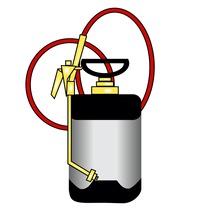
Hello, and welcome to our new updated website. We will be posting BUG info and in home prevention techniques, what we call IPM (Inaugurated Pest Management), information here in our blog. You can learn how to keep the pest under control in your home, shop and or place of business.
We will keep you up-to-date on what we are doing to improve our services to you also. Stay tuned and come check us out once in a while to see whats new.
Thanks for visiting,
June Bugs
 The June beetle, (Phyllophaga) AKA May beetle or June Bug, Genus of nearly 300 species of beetles belonging to the widely distributed plant eating subfamily Melolonthinae (family Scarabaeidea, order Coleoptera). There are more than 100 species of scarab beetles. In Texas they are considered to be white grubs in the pupae stage. Their biologies are similar, but species differ in distribution, habitat preference, length of life cycle and seasonal occurrence. You may also see the southern masked chafer, and the green june beetle. The Japanese beetle has made its way into northeastern United States and has migrated west and south, and now can be found in some Texas counties.
The June beetle, (Phyllophaga) AKA May beetle or June Bug, Genus of nearly 300 species of beetles belonging to the widely distributed plant eating subfamily Melolonthinae (family Scarabaeidea, order Coleoptera). There are more than 100 species of scarab beetles. In Texas they are considered to be white grubs in the pupae stage. Their biologies are similar, but species differ in distribution, habitat preference, length of life cycle and seasonal occurrence. You may also see the southern masked chafer, and the green june beetle. The Japanese beetle has made its way into northeastern United States and has migrated west and south, and now can be found in some Texas counties.
Life Cycle: Adults begin to emerge from the ground in spring. They can be found in numbers near lights. They can be found in numbers mid to late June in central Texas. The females are less attracted to lights. Females tunnel 2 to 5 inches into the soil and deposit between 50 and 200 small pearl-like eggs in the soil then buries them. The eggs become what is known in Texas a white grubs in 3 - 4 weeks. They develop through three stages (instars), the first two stages last about 3 weeks. The las larval stage remains in the soil from the fall through spring. The grubs develop into adults 3 to 6 inches deep in the soil. It takes about 3 weeks for the Adults to pupae from larva (grubs). Usually there is one generation per year, however in north Texas, it may take two years for a cycle.
Habitat, Food Source(s), and Damage: They have mouth parts for chewing. They are common in Texas turf grass especially Bermudagrass, St. Augustine grass and tall fescue. Large numbers of grubs can cause damage to lawns. Lawns will turn yellow and dir. When large numbers feed on the grass severely damaged grass can be rolled up like a carpet. They are known to feed on the roots of weeds, vegetable transplants and ornamental plants. They are considered a pest in relation to forage corn, sorghum and sugarcane. You may have encountered them when tilling a garden or by sifting through soil or under damaged turf grass.
Cicada Killer
 Coined "The Gentle Giant”, the scientific name for this wasp is Species Speciosus (Drury) in the order: Hymenoptera. You can identify them by the rusty red head and thorax, they are overall black with yellow band markings on the abdominal segments. The wings are rust colored. We have a few other wasps in the sphecid family of wasp that are frequent in Texas and include the digger wasp, sand wasps, mud daubers, and the tarantula hawk. Cicada Killers are harmless to humans females have to the ability to sting, however, it has been extremely rare that a female cicada has stung. Males do not have a stinger and can not sting.
Coined "The Gentle Giant”, the scientific name for this wasp is Species Speciosus (Drury) in the order: Hymenoptera. You can identify them by the rusty red head and thorax, they are overall black with yellow band markings on the abdominal segments. The wings are rust colored. We have a few other wasps in the sphecid family of wasp that are frequent in Texas and include the digger wasp, sand wasps, mud daubers, and the tarantula hawk. Cicada Killers are harmless to humans females have to the ability to sting, however, it has been extremely rare that a female cicada has stung. Males do not have a stinger and can not sting.
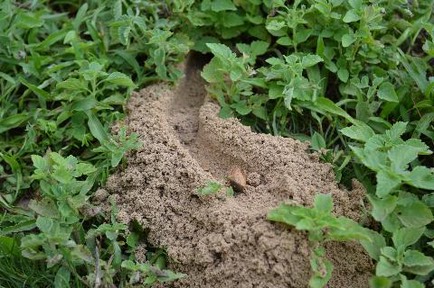
Life Cycle: The larva spend the winter in the ground in the larval or pupal stage. They emerge from the ground in the summer, feed, mate and produce new nesting burrows. The female digs a burrow with multiple cells. The burrow is approximately 6” in depth and then will be extended 90 degrees to the left
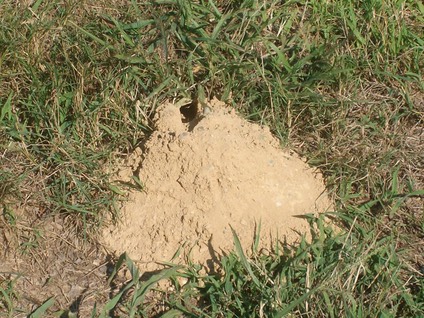
and right, or both another 6” or more. She will create cells in the burrows and deposits paralyzed cicadas she has stung and deposited an egg on. The larva hatches from the egg and molts several times (instars) before pupating inside a woven, spindle-shaped brown case measuring up to 1 1/4 inch long. She has on cycle generation per year.
Habitat, Food Source(s): They do have mouthparts and are for chewing. They like to nest in sandy and sandy loam areas. Females are solitary and each create their own nests even though they appear to be nesting in a common area. They are active in the months of July and August, This coincides 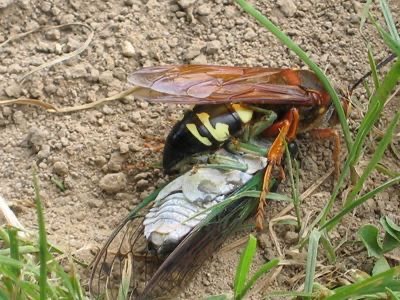 with the arrival of the cicadas. The female cicada killers attach, sting and paralyze the cicada. The female will then fly, glide or drag the cicadas back to their burrowed nests laying an egg on the paralyzed cicada and intern the larva will consume while maturing in the cell. The adults feed and consume floor nectar.
with the arrival of the cicadas. The female cicada killers attach, sting and paralyze the cicada. The female will then fly, glide or drag the cicadas back to their burrowed nests laying an egg on the paralyzed cicada and intern the larva will consume while maturing in the cell. The adults feed and consume floor nectar.
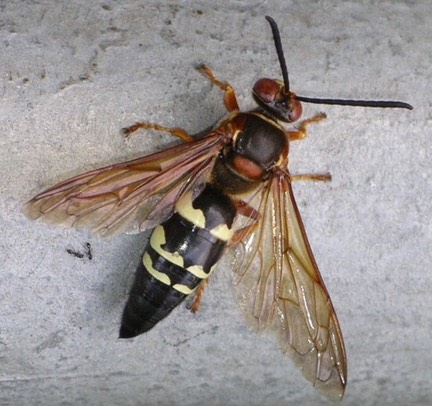
Pest Status: The cicada killer wasp is on of the largest in its family. As we have already mentioned the females are capable of shining. They are rarely aggressive towards people and animals. Males are unable to sting since they do not have a stinger. In an area where large amounts of females nest they can become a nuisance and cause concern to people because of their large size,flow flight and nesting activities. You can identify the nests of the female by a pile of soil excavated from the burrows and may have disturb grass in the area.
Earwigs

Easy to identify both the adults and nymphs have characteristic “pinchers” or forceps-like structures on the back end of their bodies. The body is black to brown in color and somewhat flattened. Nymphs do not have wings and adults have membranous wings folded underneath short cover-like forewings and they rarely fly. They have 3 pairs of well-developed legs. They make up the insect order Dermaptera. 12 families with about 2,000 species living in the world, and 20 of those species are living in the United States. They are one of the smaller insect orders. About 10 of species occur in Texas, and only a few are common. The ringleted earwig, has yellow legs with dark bands or rings on the segments. The riparian earwig, the linear earwig, and the brown-winged earwig.
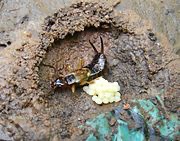
Life Cycle: Earwigs are hemimetabolous, that means they undergo incomplete metamorphosis, they develop through a series of 4 to 6 molts. The developmental stages between molts are called instars. They live for about a year from hatching. They will start mating in the autumn, and can be found together in the autumn and winter. The male and female will live in a chamber in debris, crevices, or soil 2.5 centimeters (1”) deep. After mating the sperm may remain in the female for months before the eggs are fertilized. Earwigs prefer high moisture and migrate indoors during periods of prolonged heat and drought to seek cool, moist hiding places. During the winter they can dig into the ground as deep as 6 feet to escape freezing temperatures.
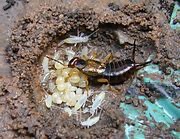
From midwinter to early spring the male will leave, or be driven out the the female. Afterwards the female will begin to lay 20 to 300 pearly white eggs in 2 days. When first laid, the eggs are white or cream-colored and oval-shaped, but right before hatching the become kidney-shaped and brow. Two generations are produced each year.
Earwigs are among the few non-social insect species that show maternal care. The mother will pay close attention to the needs of her eggs, such as warmth and protection, though studies have shown that the mother does not pay attention to the eggs as she collects them. The mother will defend the eggs from predators, not leaving them to eat unless the clutch (eggs) goes bad. Another distinct maternal care unique to earwigs is that the mother continuously cleans the eggs to protect them from fungi.
The eggs will hatch in about 7 days. The mother may assist the nymphs in hatching. The nymphs eat the egg casing and continue to live with the mother. Nymphs are similar to adults only smaller. They will net under their mother for protection until their second molt. Nymphs feed on regurgitated food by the mother they will also eat their own molts. Nymphs have been known to eat the mother if she dies before the nymphs are ready to live the nest.
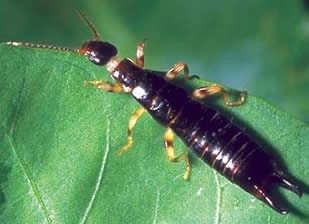
Habitat and Food Source(s): Earwigs are active at night and seek dark places during the day such as underneath rocks, bark, plant debris, and between foundations and soil. They also occur indoors, particularly during periods of unfavorable outdoor conditions. They feed mainly on both dead and living insects and mosses, lichens, algae and fungi. Indoors, their food consists of sweet, oily and greasy foods. One earwig, the European earwig feeds at night on leaves of plants.
Pest Status: Generally harmless; they feed mainly on arthropods and decaying organic matter. They can be a nuisance when they invade homes.